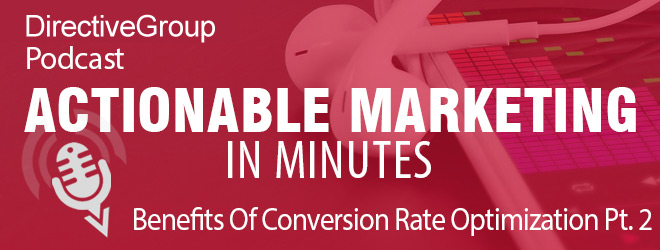In this episode of Actionable Marketing In Minutes we discuss the benefits of conversion rate optimization in the second of a three part series.
Use the player below to listen to this episode, or the download link to load it on your device for listening later. You can also find our RSS feed by clicking here, or subscribe by email in the sidebar to the left.
Download our Marketing To Millennials eBook here!
Not able to listen? Why not read the episode transcript below:
Problem:
Your first question today may be, ‘are we speaking a foreign language?’ Or, ‘is this topic as dry as I think it is?’ Please stick around. I think you’ll find this subject most illuminating. For certain, it is information you need to know.
To quickly summarize our last podcast segment, we defined the term conversion – which is when a visitor on your site does what you want him or her to do. Then we talked about how to find out what your conversion rate is along with a few observations you can make with the use of an analysis service – such as Google Analytics or KISSmetrics – that tells you why visitors may not be converting and what on your site may be influencing your visitor adversely.
Once you know what a visitor is doing on your site, you are in a better position to tweak your conversion funnel to increase – or optimize – your conversion rate.
Today, we’re going to discuss a couple of methods of conversion rate testing that will help you find where your trouble spots are. Once you know where to make adjustments, you’re well on your way to increasing your conversion rate – which will ensure more conversion success.
Solution:
The two tests I want to tell you about today are: Split Testing – also known as A/B Testing – and Multivariate Testing – also known as full factorial testing. I’ll briefly explain the methodology of each, along with common uses, advantages and limitations.
With Split Testing – which is the least complex type of testing – you are comparing, with live traffic, the conversion rates of at least two very different versions of a page – version A, version B, and sometimes even C and D. You funnel visitors into one page or another and track their clicks. This helps you to see which version is most effective.
Only a few individual elements of a page are tracked with split testing.
Split testing is widely used because it is simple, versatile and powerful. It does not require a lot of traffic and it delivers reliable results quickly.
Because split testing only measures the impact of no more than two to four variables on a page, it will not reveal more detailed information, such as interactions between those variables. Looking for that type of data will require multivariate testing.
The purpose of multivariate testing is to measure the effectiveness of each design combination using a variety of variables. It requires substantially more traffic than that of a simple split test because you are funneling visitors into many different pages and need high traffic to get accurate readings. The data from each variation of the same page is compared to determine the most effective design and which elements within that design have the greatest impact on visitor interaction. Because more variations are tested, this type of testing takes longer to obtain meaningful data.
The results of multivariate testing give you a clear picture of which page is performing best as well as which elements are most effective for that performance.
The biggest limitation with this type of testing is the large amount of traffic needed to glean accurate results. And, with so many elements tested, the number of tested combinations can easily get out of hand and slow the testing down. Sometimes, it might be best to just stick with several well-designed split tests.
Benefits:
Now that you better understand each type of conversion optimization test, you are in a better position to find your trouble spots and to correct the problems. And, as they say, knowing is half the battle.
We hope you’ve found this information helpful. Please connect with us on Twitter @DirectiveGroup or on LinkedIn. Let us know what you think and what you’d like to hear about next. And if you like our podcasts please share with your networks using hashtag #actionablemarketing.
Join us next time as we discuss the next and final topic in this conversion optimization series where we’ll discuss how to create a highly-converting landing page. We hope you’ll join us.
Podcast: Play in new window | Download (Duration: 5:41 — 2.4MB) | Embed
